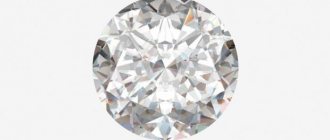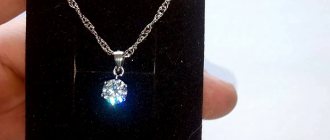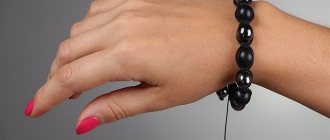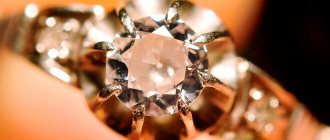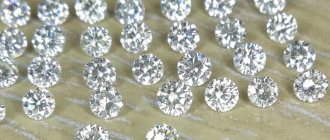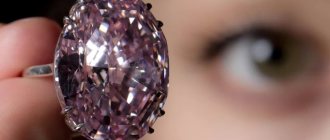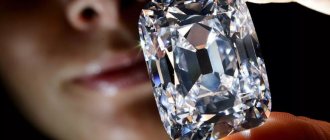October 18, 2021 The carat value of diamonds is a topic of long debate that is unlikely to subside in the coming years. The reason for this, no matter how trivial it may sound, is the high cost of the mineral. The retail price of a cut diamond is only growing, and unscrupulous sellers are constantly inventing new marking methods to hide the real mass of inlays from the buyer. That is why, when choosing a diamond ring or any other product, you need to know how much the stone weighs.
Now we will tell you how to determine how many carats are in a diamond, what calculation methods exist, and how accurate the generally accepted calculation systems are.
What is the carat value of diamonds?
History has not preserved detailed details of why the carat was recognized as the standard unit of measurement for jewelry stones, although everything happened relatively recently - in 1907. The international standard was signed by French scientists following a conference of the Paris Bureau of Weights and Measures. It is thanks to them that almost the entire world, with the exception of Anglo-Saxon countries, uses meters and kilograms instead of pounds and feet.
So, the value we are interested in is constant, but in different sources it is written in two ways - as an ordinary fraction or as a decimal fraction. One carat is equal to 1/5 or 0.2 grams, on the basis of which the net weight of the stone is calculated. It should be understood that manufacturers can and are required to indicate the total weight, and in order to measure the inlay, it will have to be pulled out of the gold cast; such an activity is problematic and requires a special jewelry tool.
Fortunately, it is quite possible to avoid radical “dissection” by going to a pawn shop or workshop - basic mathematics will come to the rescue. The two things you will need are an accurate engineering ruler with 0.1 millimeter divisions and a magnifying glass.
Why are diamonds so expensive?
In general, your understanding of how the cost of diamonds is formed has already been formed - we just need to remind you of the main parameters. The price of these magical stones, enchanting with their shimmer, is partly the result of the skill of the jeweler, but the rest is literally a matter of luck: finding a pure diamond, putting skillful hands on it, showing it in the best light.
Large diamonds/high clarity/the right color/ideal cut – the chance is literally exceptional, such stones are incredibly rare and have an unrealistically high cost.
Stones that are more widespread are also not so cheap, but the reasons are the same: characteristics, or rather their combination. In addition, it is not easy to mine diamonds; deposits of high-quality stones are located at a depth of more than 300 meters, and most of them become suitable only for technical needs. There are not many diamonds worthy of cutting even for the general market.
Let's add to everything the exceptional strength of diamonds - this is the most durable, and therefore literally eternal stone, the highest rating on the Mohs hardness scale. And against the backdrop of such advantages, the advertising campaign for high-quality, expensive diamonds carried out on behalf of De Beers at the beginning of the last century does not seem to have had much of an impact on interest in the stones. How else can we explain the passion of monarchs, kings, and rulers of ancient times for diamonds?
How to determine the carat of a diamond without a scale?
Precise microscales are a useful thing, but not cheap, and branded models approved by jewelry manufacturers are profitable to buy exclusively for stores. Therefore, it is much easier to calculate the declared mass using the formula named after the legendary French merchant Jean-Baptiste Tavernier. Back in the 17th century, he managed to calculate the direct mathematical relationship between the size of a cut diamond and its specific gravity.
The formula looks like this:
M = (d*d) * h * 0.0061
The letter d denotes the diameter, h the height, and the last factor is the proportion coefficient of the stone; it remains conditionally constant. The only practical difficulty is to measure the dimensions with an accuracy of at least one tenth of a millimeter, otherwise the calculation makes no sense.
Important: The error of the Tavernier formula is 10-15%, depending on the deviations of the measuring instruments. That is why future owners of jewelry are advised to buy an engineering ruler in advance with the lowest possible division price.
However, the difficulties do not end here. The fact is that during the life of the eminent jeweler who supplied gems to the court of Louis XIV, they knew how to give diamonds an exclusively round shape; accordingly, for others a modified calculation will be required.
World record holders
The size of diamonds in most cases does not have a decisive impact on the cost, of course, unless we are talking about huge stones, such as:
- "Star of Africa" Diamond also known as "Cullinan". It was found in South Africa in 1905. The weight of the stone was 3106 carats, 100 mm in length, 65 in width and 50 in height. Since the structure of the diamond was not ideal, it was split into several pieces, the largest of which are the property of the British Crown.
- "Our light." The diamond was found in Botswana in 2015. It is recognized as the second largest and heaviest diamond after the Star of Africa diamond. The diamond measures 6.5 cm in length, 5.6 cm in width and 4 cm in height.
- "Exilior". The diamond was found in South Africa in 1893. The weight of the stone was at least 995.2 carats. After splitting, 21 diamonds were made from it. The Exilor was at least 3 cm in diameter. Before the Star of Africa was found, it was considered the largest diamond ever found.
- "Great Mogul". A 787-carat diamond was found in medieval India. Its exact size in mm cannot be determined, since the stone was split and traces of it were lost.
Determining the size of a diamond is impossible without knowing its length, width, elongation, area size, and diameter. Also important are the height of the girdle, the angle of inclination of the edges of the top, the angle of inclination of the edges of the bottom, the width of the cut part of the girdle and the angle of the cut.
These terms are familiar to every professional. Without sufficient competence in jewelry making, it is better not to try to do it yourself. You can miscalculate the price and overpay where you shouldn’t.
Table of carat values of diamonds of different shapes
Suppose a stone of a popular cut is inserted into a gold jewelry. Each of them will have its own proportions, which means a different closing factor. There is no need to “draw” multi-story equations - everything has been calculated long ago, the results are listed in a table:
| Cut style | Aspect Ratio | Coefficient |
| Emerald or baguette | 1:1 | 0,008 |
| 2:1 | 0,01 | |
| Marquis | 1,5:1 | 0,0056 |
| 2:1 | 0,0058 | |
| Pear | 1,25:1 | 0,006 |
| 2:1 | 0,0057 |
Accordingly, in the formula, instead of the square of the diameter, the length and width along the largest sides are added. The calculation takes the form:
M = d*a*h*k
Instead of the letter k, all that remains is to substitute the value of the rightmost column. The aspect ratio is usually written on the certificate; if it is missing, do not hesitate to contact the seller.
How many carats are in the finished jewelry?
Sometimes, for one reason or another, you want to know how many carats are in a gemstone of an existing piece of jewelry. Today, almost every jeweler has a special scale for grading diamonds. A professional knows exactly how to determine how many carats are in a stone . Carat is measured to two digits after the decimal point, and this value is rounded down. This means that if the diamond scale reads 0.999, the recorded weight of the diamond will be 0.99 carats (or 99 points).
How to read the tag on a diamond item?
After we have learned how to calculate the weight of a gemstone, it is time to compare the real numbers with what the jewelry store offers us. The jewelry tag, as required by Russian law, contains all the technical information about the mineral, but to save space it is printed in an encrypted abbreviated format, for example, like this:
Engagement ring, 585, art.000000000, 1Br, 3.4-4, Kr57, 2.2 g
Here you can see that the word “carat” is missing altogether, but this is not a reason to panic and declare it a fake. The fact is that instead of an exact value, domestic manufacturers often indicate diamond screening - a range value for the number of stones (pieces) that fall on 1 carat of cut diamonds after the screening procedure through special sieves.
To decipher what has been said, let us turn to the table for the last time in this article.
| Size and weight classification of diamonds | ||
| Sieving coefficient | Carat weight | Diameter in mm |
| 200-400 | 0,002-0,005 | 0,70-1,10 |
| 90-120 | 0,008-0,009 | 1,30-1,40 |
| 30-40 | 0,025-0,029 | 1,90-2,00 |
| 7-10 | 0,100-0,139 | 3,00-3,30 |
| 3.4-4 | 0,250-0,299 | 4,10-4,30 |
Knowing the common coefficients, calculating the mass is not difficult; you just need to divide the unit by the number indicated with a hyphen by the larger indicator. The resulting decimal fraction will be the desired value with a minimum error.
Now let's return to our tag, the code on which should be read as follows: engagement ring made of 585 gold with one diamond weighing up to 0.3 carats, classic round cut with 57 facets. The total weight of the product is always indicated in grams.
Change in mass relative to diameter
The round cut is the most popular in its application; it allows you to reveal the brilliance and purity of the stone.
The higher the diameter, the correspondingly higher the carat weight:
- the gemstone, which weighs 0.2 carats, has a size of 3.8 mm;
- Ø 5.1 mm – 0.5 carats;
- Ø 4.4 mm – 0.33;
- Ø 6.4 mm – no more than 1;
- Ø 8.1 mm – 2;
- Ø 9.4 mm – 3;
- Ø 16 mm – 15.
Such stones are divided according to quality into groups:
- impeccable – A;
- high – B;
- good – B;
- satisfactory – G.
High-quality finishing makes the stone extraordinary, with pure shine and radiance. Round diamonds have sparkle, attract attention thanks to the play of light, and emit inner brilliance, which is why their price and value are higher than others.
Diamonds, size and carat. Interesting Facts
While preparing this article, we collected several interesting details:
- The international cost of 1 carat of diamond in 2021 approached the mark of 20 thousand dollars (about 1.5 million rubles). However, this amount only applies to crystals of the highest quality and purity, which is extremely rare in mass production.
- Before the standardization of values in the 20th century, each region measured the value of stones in its own way. The seeds of barley, acacia and other dense varieties were used.
- The only country that has categorically abandoned the karate system is Japan. There, the mass of inlays is measured in funami (375 mg) or momme (3.75 g).
- The Arab world calls the unit of weight for jewelry the qirat, and its value in the metric system is 0.223 grams.
- The “folk” size of a pebble is considered to be a diameter of up to 3 mm and a weight of 0.1 kr. With average clarity and cut, the cost of the mineral does not exceed $200.
- The largest diamond in history - the Star of Africa or Cullinan - weighed 621 grams before division. Now its fragment adorns the scepter of the British King Edward VII, which can be admired in the permanent exhibition of the Tower of London.
- The bean seed of the pod ceratonia, or rather its Greek name, gave birth to the word carat. At least that's what the Greeks themselves think.
The Karatov online store will help you choose and buy jewelry with natural diamonds for every taste and budget, and if you have any questions, contact us through the feedback form. We guarantee maximum quality and authenticity of each product.
The price of a 1 carat diamond: what it depends on
Determining the mass and diameter indicators is not enough to indicate the final cost. Quality also matters. A tapeworm that best meets the requirements for the main parameters is more expensive. The price of some specimens of just 1 carat amounts to several thousand dollars. Stones with minor defects and the same parameters will cost two or even three times less. A stone with serious damage can be purchased for no more than $1,000.
In the jewelry world, it is practiced to evaluate stones in accordance with an established system, it is called 4 C. The following indicators are taken into account:
- color (color) - associated with the components included in the composition, is preserved and does not change over time;
- cut level;
- purity is analyzed at 10x magnification;
- mass (carat).
The final assessed value is added up according to Tavernier's rule. Use a calculator to calculate. Use it to multiply the carat cost data with the square of the weight. You can follow a pattern: a 2-carat solitaire will be twice as expensive as a one-carat diamond, and a 10-carat diamond is 100 times more expensive than a one-carat diamond. Large exclusive specimens of more than 20 carats are very rare. All of them are kept in private collections, museums, and put up for sale under their own names.
Purity
Before choosing jewelry or stones separately, consider not only the carat value, but also the clarity of the diamonds. The radiance of stones is determined by their ability to transmit light rays: the lower the purity index, the less pronounced their shine.
Absolutely pure stones without any inclusions are quite rare, which affects their cost. Such samples are often sold without frames, and they are subject to mandatory certification. To assess the clarity of diamonds, there is an international scale consisting of 11 levels: from IF - an absolutely pure stone, to I3 - a diamond with defects and inclusions.
The Russian classification provides:
· for small stones - 9 purity groups;
· for large ones - 12 purity groups.
Perfectly clear diamonds receive a 1, while those with noticeable and/or numerous inclusions receive a 12.
If your goal is to choose diamond jewelry for beauty and not for investment, take a closer look at diamonds that belong to groups 3–4 in color and 1–7 in clarity. As a rule, it is better not to purchase stones of levels 9–12 - due to numerous defects, they often split and do not look very attractive.
How to distinguish natural stone from synthetic
Artificially grown diamonds are similar in physical and optical characteristics to natural ones. They are almost completely identical, except that synthetic stones are created in laboratory conditions.
Experts will help you accurately determine the origin of a gemstone. It is also quite possible to independently verify the authenticity of a diamond: for this you will need an ultraviolet lamp. Under the influence of ultraviolet light, natural stones glow with a light blue hue. Synthetic counterparts will typically have a yellow or green cast.
Estimation using formula.
You can also calculate the approximate carats of a round diamond using the following formula:
Carat Weight = Diameter x Diameter x Depth x 0.006
The diameter of a round stone is the length of an imaginary line that passes through its center (when looking at the diamond from above) and connects two points located opposite each other on the girdle (at the edges).
Depth is defined as the distance from the top facet of the stone (table) to a point at the bottom of the diamond (if there is a facet there, it is called a “culet”).
For example, if you have a round diamond with a diameter of 6mm and a depth of 3.5mm, then its weight can be calculated as follows:
6 mm x 6 mm x 3.5 mm x 0.006 = 0.76 ct
This result is considered to be an estimate as the actual carat weight may vary by at least 5-10% in either direction i.e. the actual value may be from 0.70 to 0.80.
Color
Colorless stones
Transparent stones are considered the most valuable. Colorless diamonds are divided into nine groups. The first group includes absolutely transparent stones, and the ninth group includes brownish or visible yellowish stones. Stones of groups 3–5 are considered popular. There is also a letter-based international classification, in which the color of stones is distributed from D to Z.
It is impossible to visually notice the difference between the stones of the third and fourth, as well as the fourth and fifth groups. At the same time, the difference in price is quite noticeable. Therefore, when the question is which diamond to choose, the decision depends on whether you are willing to overpay.
Colored stones
The cost of colored diamonds is affected by the brightness and saturation of the hue. Most often, colored options are cheaper than colorless ones, but there are exceptions. Thus, stones of the so-called fancy colors can be more expensive than the most transparent samples.

